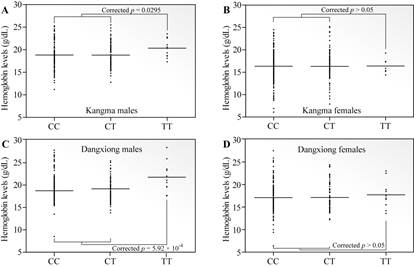How to adapt to the extreme hypoxic environments at high altitude is a hot study in evolution. Tibetans are well adapted to high-altitude environments. As a complex adaptive trait, adaptation to high-altitude environment could be the result of multiple gene interactions. Previously, several candidate genes have been reported, besides EPAS1 and EGLN1 (the major upstream regulators in the hypoxic pathway), a downstream gene (HMOX2) involved in heme catabolism may involve in the hemoglobin regulation in Tibetans.
In order to investigate the function of HMOX2 in high-altitude adaptation, the researchers from Professor Su Bing’s lab in the Kunming Institute of Zoology, Chinese Academy of Sciences initially resequenced 47 Tibetan individuals from multiple Tibetan populations, covering the complete gene region of HMOX2, and identified a functional SNP (rs4786504) in intron 1 that show divergence between Tibetans and lowlander populations. Neutrality test has confirmed the signal of Darwinian positive selection on HMOX2 in Tibetans. Subsequent association analyses of hemoglobin levels in two independent Tibetan populations (a total of 1,250 individuals) showed a male-specific association between the HMOX2 variants and hemoglobin levels. Furthermore, the in vitro experiments indicated that the C allele of rs4786504 could increase the expression of HMOX2, presumably leading to a more efficient breakdown of heme that may help maintain a relatively low hemoglobin level at high altitude. Collectively, they demonstrate that HMOX2 contributes to high-altitude adaptation in Tibetans by functioning as a modifier in the regulation of hemoglobin metabolism. This study have published on 《Human Mutation》(http://onlinelibrary.wiley.com/doi/10.1002/humu.22935/abstract).
YANG Deying (PhD student), PENG Yi (Associate Professor), the co-researchers from Tibetan University and the Municipal People’s Hospital of Lhasa are the first co-authors of this paper; professor Su Bing and associate professor Qi Xuebin are the corresponding authors. Contract grant sponsors: Strategic Priority Research Program of the Chinese Academy of Sciences; the National 973 Program of China; the National Natural Science Foundation of China; State Key Laboratory of Genetic Resources and Evolution; the Zhufeng Scholar Program of Tibetan University.
(By PENG Yi)
Contact:
SU Bing
32 Jiaochang Donglu, Kunming 650223, Yunnan
Kunming Institute of Zoology, Chinese Academy of Sciences
Email: sub@mail.kiz.ac.cn

Legend: Comparison of hemoglobin levels among three genotypes (CC, CT, and TT) at rs4786504 in Tibetan males and females from two geographic Tibetan populations.
